Kerala.com Travel Division
WorldViewer Dot Com (India) Pvt. Ltd.
II Floor, G 66, Elders Forum Road
Panampilly Nagar, Cochin, Kerala, India
Pin - 682 036
Mobile: + 91 98460 43403
Mobile: + 91 93886 40364

Kerala Health Tourism << Ayurveda << Ayurveda Malappuram << Silent Valley Ayurvedic Health Resort
All Classical Ayurvedic treatments are done at the ayurvedic spa of our resort under the able guidance of experienced physicians and well trained therapists. Facilities are available for Panchakarma as well as preparatory and post procedural management according to the need of the patient. List of major treatments and their brief descriptions are given below.
Abhyangam Abhyangam is application of oil on head and body followed by gentle massage of body by a 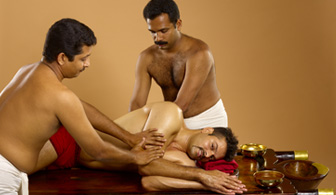 trained therapist. The patient will be on the special table and will take seven positions like sitting, lying on back and side etc during the treatment. Abhyanga is done as a single treatment and as a preparation for or along with major treatments. The duration of this treatment is 45 minutes, followed by a bath using green gram powder to remove the oil. The physician will decide the suitability of the patient for this treatment and also the oils suitable for him/her. This treatment is done for a day or for any number of days as prescribed by the physician to suit the conditions and the treatment taken along with it.
trained therapist. The patient will be on the special table and will take seven positions like sitting, lying on back and side etc during the treatment. Abhyanga is done as a single treatment and as a preparation for or along with major treatments. The duration of this treatment is 45 minutes, followed by a bath using green gram powder to remove the oil. The physician will decide the suitability of the patient for this treatment and also the oils suitable for him/her. This treatment is done for a day or for any number of days as prescribed by the physician to suit the conditions and the treatment taken along with it.
Pizhichil Pizhichil means squeezing. Pizhichil is the process where cotton cloth pieces are dipped in warm 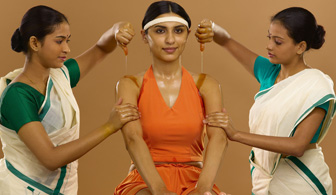 medicated oil and squeezed onto the patients body. Here the patient is smeared with appropriate medicated oils on the body and head. Then the therapeutic assistants two on either side of the specially designed wooden table dip clear cotton cloth in warm medicated oil and squeeze in onto the patients body. Like Abhyangam, Pizhichil is also done with patient in seven positions. This process is followed by a bath using a green gram wrap and warm water for the body and lukewarm water for the head.
medicated oil and squeezed onto the patients body. Here the patient is smeared with appropriate medicated oils on the body and head. Then the therapeutic assistants two on either side of the specially designed wooden table dip clear cotton cloth in warm medicated oil and squeeze in onto the patients body. Like Abhyangam, Pizhichil is also done with patient in seven positions. This process is followed by a bath using a green gram wrap and warm water for the body and lukewarm water for the head.
Pichu Pichu is an external oil application, superior to abhyanga in potency. Pichu is done only to the affected parts, like head, low back etc. It is done as a major treatment and a simplified version of it is done along with other oil treatments like abhyanga. A dry cotton cloth having the size sufficient enough to cover the area of application, when folded is taken. The thickness of the folded piece should be preferably that of the palm. A hole is made in the center of the folded cloth to pour oil perodically. Duration of the treatment varies according to the condition and the treatment along with which it is done. This treatment is done for a day or for any number of days as prescribed by the physician to suit the conditions and the treatment taken along with it.
Thakradara This treatment is pouring of medicated buttermilk on the forehead. The treatments start with oil 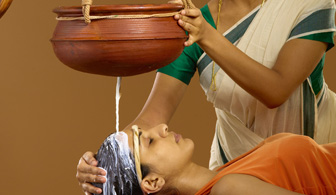 application on head and body. Then a cloth piece is tied around the patients forehead to protect oil from dripping to the eyes. Patient is made to lie on the treatment table on his back and the wick hanging from the Dhara pot should be 4 fingers above his forehead. Then medicated oil is poured into the Dhara pot after heating to mild warm condition. The flow is adjusted to make it straight and this is allowed to fall on patients forehead and this is continued for the specific duration. Oil massage is given to the patient at the end of this treatment.
application on head and body. Then a cloth piece is tied around the patients forehead to protect oil from dripping to the eyes. Patient is made to lie on the treatment table on his back and the wick hanging from the Dhara pot should be 4 fingers above his forehead. Then medicated oil is poured into the Dhara pot after heating to mild warm condition. The flow is adjusted to make it straight and this is allowed to fall on patients forehead and this is continued for the specific duration. Oil massage is given to the patient at the end of this treatment.
Sirodhara In this treatment medicated fluids-oils, milk or buttermilk are poured on the forehead in a special way. The most common method is used with medicated oils. The treatments start with oil application on head and body. Then a cloth piece is tied around the patients forehead to protect oil from dripping to the eyes. Patient is made to lie on the treatment table on his back and tip of the wick hanging from the Dhara pot should be 4 fingers above his forehead. Then medicated oil is poured into the Dhara pot after heating to mild warm condition. The flow is adjusted to make it straight and this is allowed to fall on patients forehead and this is continued for the specific duration. Oil massage is given to the patient along with Dhara.
Sirovasti Sirovasti is the most intensive, potent external oil application.
Sirovasti is a special technique to administer medicated oil on the head. The patient is made to sit upright on a wooden stool and medicated oil is applied on the body and head. Then a cap made of flexible leather, open on both sides is fitted on the head and the prescribed medicated oil, slightly warm, is poured onto the cap. The oil is allowed to remain inside the cap for about 45 minutes or till the manifestation of proper signs of efficient treatment, which ever is earlier, and drained out. Afterwards the head is wiped with a clean dry cotton cloth. Again medicated oil is applied on the body and head and the patient is given a body bath in warm water. This treatment is done for maximum seven days and requires equal number of days for preparation and for having the post intensive treatments (i.e.21 days are required for a full course). Sirolepa The application of herbal paste on the patients head is called Sirolepa. The most commonly used herb is pericarp of the fruits of Indian gooseberry cooked in buttermilk. The patient must sit on a stool facing east after applying oil on head and body. A piece of cloth is tied around the forehead just above the ears. Then the medicinal paste is applied on his head in a thickness of one finger. A gap is made at the center of the head by removing medicinal paste from that part. Banana leaf made into cone shape is kept over his head. Mild massage is done on his body and neck during the treatment.
Kizhi
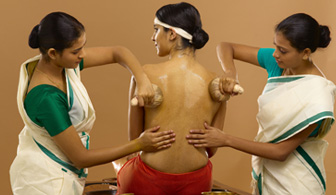 Kizhi means bundle. This treatment is meant to induce perspiration. Bundles are made out of Herbal powder, Leafs, Special variety of rice. Kizhi treatments start with Oil application. Patient is given oil application on head and body lying on a wooden bed. Then Kizhi is heated in a pan with suitable fluids or oils and applied on patients body by therapeutic assistants standing on either sides of the table. One Therapist is engaged in heating the Kizhi. Usually eight or four or 2 Kizhi are prepared as per the requirement and half of them are heated while the others are used for applying on the patients body. It is applied in such a way that the Kizhi reaches all parts of the body except face and head.
Kizhi means bundle. This treatment is meant to induce perspiration. Bundles are made out of Herbal powder, Leafs, Special variety of rice. Kizhi treatments start with Oil application. Patient is given oil application on head and body lying on a wooden bed. Then Kizhi is heated in a pan with suitable fluids or oils and applied on patients body by therapeutic assistants standing on either sides of the table. One Therapist is engaged in heating the Kizhi. Usually eight or four or 2 Kizhi are prepared as per the requirement and half of them are heated while the others are used for applying on the patients body. It is applied in such a way that the Kizhi reaches all parts of the body except face and head.
Swedana
Steam chamber is used for this. Oil should be gently applied on the body and the patient is made to sit in the chamber where steam emanates from boiling herbal decoction. Treatment should be continued till the forehead and abdomen sweat very well. Eyes are to be protected and wrapped with a piece of cloth while doing sudation. Eyes, feet, palms, chest and testicles should not be heated very much. Bathing should be done after when the sweat is completely dried up. Slightly warm water should be upset for bathing. Food can be taken after one hour, which is warm, unctous and light.
Vasti Vasti (administration of medicine through rectum) is another sodhana/purification treatment. Vasti is the treatment where herbal medicines like medicated oils/ decoctions/ medicated milk / ghee is administered through rectum using an instrument called Vasthiyantra. Vasti is of three types - Kashayavasti, Snehavasti and Uttaravasti. Among these Kashayavasti and Snehavasti are most commonly practiced. In Kashayavasti the treatment is done with a combination of honey, rocksalt, oil, herbal paste and decoction In Snehavasti-medicated oil and ghee is administered through rectum. In Uttaravasti, vasti is given through urethral or vaginal tract. A course of both Kashayavasti and Snehavasti. Kashayavasti is Sodhana - it purifies the body by expelling the impure doshas from the body where as Snehavasti is Brimhana - it nourishes and lubricates the body. These two treatments are always used in combination, thus producing a balance of purification and nourishment in the body. In the usual procedure Snehavasti is given first to lubricate the body. This followed by Kashaya to purify the body.
Nasyam is meant for cleaning the head region. Patient is asked to lie down on his back on a wooden cot placed 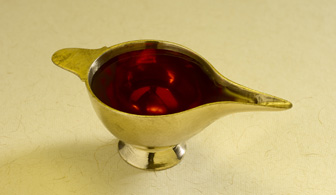 in a room devoid of breeze. Head should be placed slightly down and legs higher. Body especially head, neck and chest should be massaged with oil and fomentation is given Nasyam is of three types:
in a room devoid of breeze. Head should be placed slightly down and legs higher. Body especially head, neck and chest should be massaged with oil and fomentation is given Nasyam is of three types:
Virechana Nasyam: This type of Nasyam treatment purifies by expelling Doshas from the head region. In this type of Nasyam strong medicines are used to expel out the Doshas instantaneously from the head region.
Brimhana Nasyam: This Nasyam treatment nourishes and strengthens the head region, senses and intellectual functions. It builds up the weaker parts and is indicated in Vata diseases of the head like migraine, loss of voice, diseases of mouth, difficulty in opening eyes and difficulty in lifting hand. Meat soup and ghee medicated with herbs are used as medicines.
Samana Nasyam: This type of Nasyam subsidises the increase Dosha without expelling it out. It is moderate, neither too strong not too mild. This is good mainly in conditions like skin discolouration, hair loss, eye diseases, Medicated water and milk can be used for this purpose. Amount of medicines used: It can be either 4 drops or 6 drops of medicated oil depending upon the Dosha involvement.
Chavutti Thirumal Chavitti Uzhichil is a unique massage treatment – a blend of Ayurveda and Dhanurveda (Archery). This massage is done on the whole body using mainly the feet and also the palms by the masseur, putting medicated herbal oil all over the body and head of the person. The master gently moves the feet controlling the pressure, balancing on a rope hung on the ceiling. It needs more than an hour to complete the entire procedure. Though the process is very laborious, it gives very relaxing and soothing experience to the person who undergoes this treatment. This massage technique is originally from the state of Kerala – extreme south of India, being used and kept alive in their Martial Art practice – Kalaripayattu. Beneficial for healthy people who want to enhance their strength and vitality. Good to develop mental stability and strength. The Marmas (vital points) are well massaged and manipulated. Energy and vitality of the body is increased.
Yoga Yoga is an ancient Indian body of knowledge that dates back more than 5000 years ago. The word 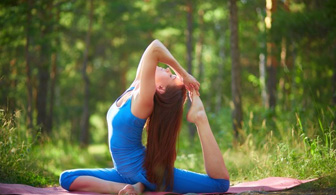 "Yoga" came from the Sanskrit word "yuj" which means "to unite or integrate." Yoga then is about the union of a persons own consciousness and the universal consciousness.
"Yoga" came from the Sanskrit word "yuj" which means "to unite or integrate." Yoga then is about the union of a persons own consciousness and the universal consciousness.
Yoga brings down stress and enhances powers of relaxation ,Boosts physical strength, stamina and flexibility and Bestows greater powers of concentration and self control.
Pranayama In Yoga Sutras, defines Pranayama as “regulation of incoming and outgoing breath coupled with retention.The latter means control; it describes the action of Pranayama. Prana – that most people are unaware of – is vital energy. It is that energy that manifests itself as the self-energizing force embracing one’s body. When this force enfolds the entire body with control, it is called Pranayama.
WorldViewer Dot Com (India) Pvt. Ltd.
II Floor, G 66, Elders Forum Road
Panampilly Nagar, Cochin, Kerala, India
Pin - 682 036
Mobile: + 91 98460 43403
Mobile: + 91 93886 40364

Kerala Districts : Alappuzha | Ernakulam | Idukki | Kannur | Kollam | Kottayam | Kozhikode | Kasargod | Malappuram | Pathanamthitta |Palakkad | Thiruvananthapuram | Trichur | Wayanad
Other Destinations :Nelliyampathy | Kodanad | Fortkochi | Marari | Kulamavu| Cherai | Kanyakumari | Kumbalangi| Kuttikanam | Ramakkalmedu|Vaikom |